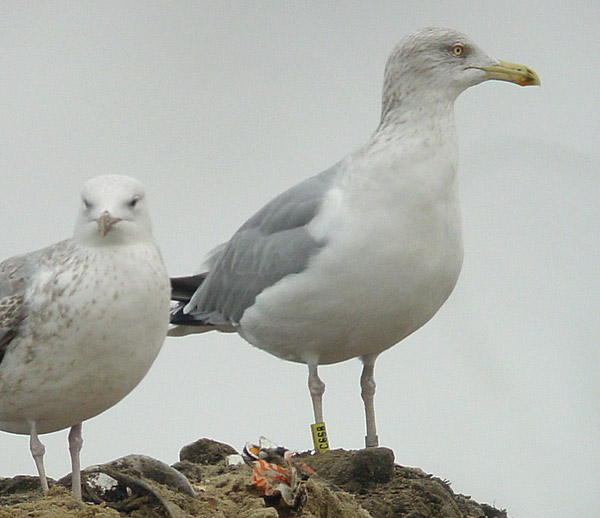 Herring
Gull - Zilvermeeuw (argentatus & argenteus)
Herring
Gull - Zilvermeeuw (argentatus & argenteus)
(last update: 14 september 2004)
Home
Links
to Gull Sites
Gull Taxa
Gull Topography
Grey & Colour Charts
Locations in NW Europe
Summaries of Articles
About ORG
@
Herring Gull C658 adult (argentatus), January 16 2004, Lubna rubbish dump, Poland (52°02'N 21°08'E).
C658 was ringed in Finland, probably in 1997.Note the size of the black markings on the bill in this bird.

Adult birds from the western populations argenteus
show more black in the outer primaries, compared to northern argentatus.
In argenteus, P5 normally shows
small black sub-terminal markings, concentrated on the
outer-web as a clear-cut black angular spot and in some birds extending on
the inner-web as a diffuse streak. There may be some black on P4 as well,
although this might be a clue for near-adult birds. In argentatus, especially from
far northern Scandinavia, the black
marking on P5
is completely lacking or is very limited and diffuse.
Argenteus often has a black sub-terminal band on the top of P10, dividing the tip from the mirror. If
the black sub-terminal band on P10 is broken, there is often still black
on the inner and outer-web's edge of P10. Normally argentatus lacks sub-terminal
markings on the outer-web of P10.
In adult Herring Gull, the scapular coverts are plain grey, lacking white crescents. The tertials
show obvious white tips. The iris is yellow. The bill is yellow with a red
gonydeal spot, confined to the lower mandible. The orbital ring is
yellowish or yellow-orange in argenteus; slightly orange-red or
coral red in most argentatus; especially birds from the Baltic region
show a bias to reddish orbital rings. The legs are flesh-pink in argenteus, but
may show a yellowish hue or appear very clear yellow in some argentatus
(from either the Baltic region or far northern Finnmark). Furthermore,
adult argentatus from Finnmark also seem to develop
"bubble-gum" pink legs.